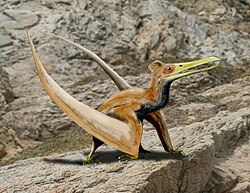Ningchengopterus
| Ningchengopterus | |
|---|---|

| |
| Life restoration | |
| Scientific classification | |
| Domain: | Eukaryota |
| Kingdom: | Animalia |
| Phylum: | Chordata |
| Order: | †Pterosauria |
| Suborder: | †Pterodactyloidea |
| Genus: | †Ningchengopterus |
| Type species | |
| †Ningchengopterus liuae Lü, 2009
| |
Ningchengopterus is a genus of pterodactyloid pterosaur from the Early Cretaceous period (Aptian stage). Its fossil remains were found in the Yixian Formation of what is now China.
It is known from a juvenile specimen,
Ningchengopterus was typified by the possession of about fifty teeth, twelve in each upper jaw and thirteen in each lower jaw. The teeth are curved, conical and pointed. The skull has a length of thirty-eight millimetres. The snout is elongated and tapering. The lower jaws show an incipient crest.[1]
The specimen could not be more precisely determined than
The teeth suggested that Ningchengopterus was a fish eater. The fully formed flight membrane was seen as confirmation of a hypothesis by Mark Unwin that pterosaurs displayed little parental care, their "babies" being able to fly shortly after hatching.[1]
